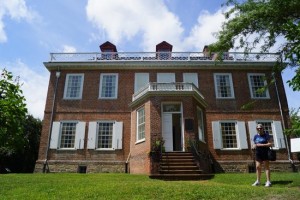This dataset consists of numeric, text and geographic data. It illustrates slave sales that took place during the years of 1775 to 1865 in different states. The slaves sales took place in 8 states. These states include Georgia, Louisiana, Virgina, North Carolina, South Carolina, Maryland, Tenessee, and Mississippi. The numeric data tells us the age of each slave in years and months. It provides the date of each sale along with the appraised value of each sale. The textual portion of the dataset provides the gender of each slave. It also provided the skills and defects of each slave. Some skills that were mentioned are a carpenter, driver, cook, house servant, laundry, midwife, nurse, painter, seamstress, cartmen, laborer, and blacksmith. Some defects that the slaves had were children, hernia, sickness, old age, blindness, loss of body parts, mental insanity, pregnancy, and deafness. Having defects caused the slaves appraised value to decrease tremendously. The were valued the least. Slaves who had skills were valued the most. If a slave had no skill and no defect it was still valued fairly. The age of the slaves ranged from 0 to 99 years old. A slave that was really young or really old and did not have the ability to do work had little to no value. For example, a male that was 1 year old had a value of 50 while a female of the same age was valued 150. A female that was 99 years old had little to no value while a male that same age had a value of 100. The years ranged from 1742 to 1865. The range of the appraised value has a minimum of -800 and a maximum 525000. The geographic locations start north and end in the south. It ranges from Maryland to Louisiana. The skills range from skinner to blacksmith. I’ve ranged this according to the appraised value. This helped to see which slave was worth more depending on what skill they had. The defects ranged from being deaf to being blind. This was also determined according to the appraised value. Each row of data is different. There are nine rows in total. Starting from the left, the first row is the geographic location where each sale occurred. The second row is the country code. The third row is the date of each sale. The fourth row is the gender of each slave. The fifth row is the age of each slave in years. The sixth row is the age of each slave in months. The seventh row is the appraised value of each slave sale. The eighth row is the skills of each slave. Finally, the ninth row is the defect of each slave.
After analyzing the slave sale dataset, it took several attempts to find relationships between the rows. My first failed attempt was thinking there was a correlation between the date of sale and the appraised value of a slave. I did not take into consideration the gender, age, location, skill, and defect of the slaves. A slave in the 1700’s was valued anywhere from 0 to 900. A slave in the 1800’s was valued anywhere from -800 to 525000. I came to the conclusion that there was no correlation between the two because there were many other factors that determined the appraised value. I later then discovered three other relationships. The first was the correlation between the gender of the slave and the appraised value. Male slaves have more value than females slaves especially if they had a skill. The second relationship was between the value of a slave if they had a defect and the value of a slave if they did not have a defect or a skill. A slave without a defect or skill was worth more than a slave with a defect. The third relationship I focused on was the value of a slave in its prime age (20-40) and the value of a slave that was either younger than 20 or older than 40 years of age. Slaves that were in their prime age were worth more.

